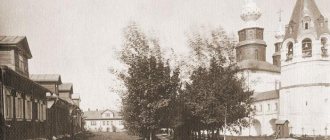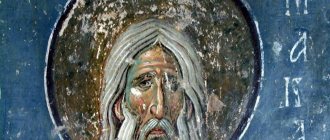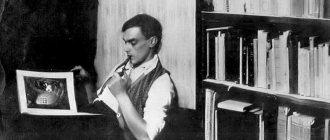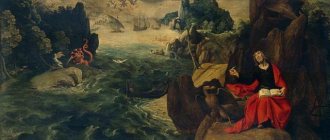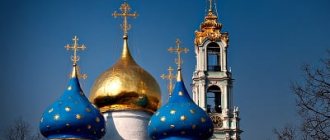Life of St. Daniel of Pereyaslavl
The Monk Daniel, known in the world as Demetrius, was born around 1460 in the city of Pereslavl-Zalessky. From a very young age, the monk strove towards an ascetic life and began to imitate the exploits of the Monk Simeon the Stylite. The God-loving youth was sent to study at the Nikitsky Monastery, which was led by his relative, Abbot Jonah. Here he made the final decision to completely devote his life to serving God in the monastic rite. Fearing obstacles from his parents, he secretly with his brother Gerasim retired to the monastery of St. Paphnutius of Borovsky. Here the Monk Daniel took monastic vows and for 10 years labored under the guidance of an experienced elder, the Monk Leukius of Volokolamsk (July 17, 1492).
In 1491, the monk returned to his hometown, to the Goritsky monastery, where he was awarded the priesthood. Leading a strictly ascetic lifestyle, Saint Daniel also chose special work for himself: he looked for dead homeless, beggars and rootless people and took care of their Christian burial. If he heard about a person who died from robbers, about a drowned person, or someone who froze to death on the road, for whom there was no one to perform a funeral service or bury him, he tried to find him and move him to the skudelnitsa (a burial place for the homeless). The monk made sure that the newly found body was buried, and he himself prayed for the nameless deceased at the Divine Liturgy.
The Monk Daniel grieved greatly for the deceased wanderers and eventually decided to build a temple in this place in the name of All Saints, so that prayer would be offered in it for the repose of unknown dead Christians. By decree of Grand Duke Vasily Ivanovich, he received a charter for ownership of the place where he planned to build a church and, with the blessing of Metropolitan Simon, on July 15, 1508, the Church of All Saints was consecrated and ready for worship.
Soon, monastic cells appeared around the church and a small monastery was formed, where the Monk Daniel became abbot (according to various sources in 1511, 1523 or 1525). One of the main commandments of the saint was about love of strangers, to receive and care for strangers, the poor, the poor and the sick.
One of the best disciples of the Monk Daniel who lived in the monastery was the Monk Gerasim of Boldinsky (May 1, 1554), who later became the founder of several monasteries in the Smolensk region.
Saint Daniel was an experienced and loving leader, he knew how to find a special approach to each of his charges in order to enlighten and guide them to the path of salvation. There was a case when a German monk who labored in his monastery (who had previously been a doctor) fell into great despondency because he did not believe that his soul would be saved and did not listen to any admonitions of the brethren. One day Abbot Daniel said to this brother: “Let the one who wants to avoid eternal death have faith in God, and he will never die!” The brother got angry and replied: “We are all subject to death! Are you thinking of avoiding her alone? Stop mocking me!” Then the monk ordered all the brethren to tell him: “Why do you grumble against your father? He tells the truth to you that those who live here according to the commandments of God will not see death. The soul of the righteous, having been separated from the body, passes with the saints into eternal life, prepared by God for those who love Him” (see 1 Cor. 2:9). These words finally touched my brother’s soul. He asked for forgiveness and since then has strengthened his faith and found peace of mind.
The blessed elder reposed on April 7, 1540, in the 81st year of his difficult life, having accepted the great schema before his death. At this time it was solar. Having prepared for the next world, the elder saw three wonderful monks who visited him one day in the Goritsky monastery. Having given the last blessing to everyone, he peacefully departed to the Lord and was buried near the Trinity Cathedral on the north side.
Venerable Daniel of Pereyaslavl and the Russian autocrats
Thanks to his highly virtuous life, the Monk Daniel enjoyed the deep respect of Grand Duke Vasily III and was his spiritual father. In the fall of 1510, while on a pilgrimage in the city of Pereslavl, Vasily III visited the Danilov Monastery, where he became better acquainted with its founder and donated a bread basket for the brethren. Thanks to the grand ducal support, in the young monastery, where about seventy monks had already gathered, it became possible to build new churches and additional cells.
After some time, the Grand Duke persuaded the humble Daniel to accept the abbess of the hostel he founded. At the end of 1528, the childless Prince Vasily and Grand Duchess Elena, making a pilgrimage to the northern monasteries to pray for the birth of an heir, visited the Danilov Monastery. According to legend, it was thanks to the prayers of the Monk Daniel that the Grand Duke finally gave birth to a son - the future Tsar Ivan Vasilyevich the Terrible. Together with other worthy monks, the monk became the godfather of both sons of the Grand Duke: Ivan and George; according to the custom of that time, he carried the young king in his arms at the great entrance during the singing of the Cherubim. In honor of the birth of the long-awaited first-born, the Grand Duke made a donation for the construction of the first stone church in the Danilov Monastery - the Trinity Cathedral, with a chapel in the name of the heavenly patron of the prince, St. John the Baptist.
The young Tsar Ivan Vasilyevich, following the example of his father, also deeply revered the already deceased saint. It was thanks to his decree that the first life of St. Daniel, based on the memories of still living eyewitnesses. In 1552, during the siege of the city of Kazan, the tsar’s confessor, Archpriest Andrei, a close disciple of the saint, prayed to St. Daniil about the victory of the Russian army. The monk appeared to him in a dream vision and informed him that his prayer had been heard and that King John would defeat his opponents. Andrei himself (the future Metropolitan of Moscow and All Rus' Athanasius) predicted that he would subsequently accept monasticism and become a metropolitan.
DANIEL
D.'s parents were the small service landowner Konstantin and Thekla (after the death of her husband, she took monastic vows with the name Theodosius). D.'s father with his wife and children left Mtsensk earlier in 1437 together with the Mtsensk governor Grigory Protasyev, who transferred to serve in Moscow by order of the leader. book Moskovsky Vasily II Vasilievich. D.'s family settled in Pereslavl-Zalessky, where he was born. saint, named Demetrius in Baptism. Even in adolescence, he showed ascetic inclinations. Having once heard the reading of the Life of St. Simeon the Stylite and deciding to imitate the saint, the boy secretly wrapped the body with a rope, which he cut off from the boat of the Tver merchants, standing on the bank of the river. Trubezh. The rope dug into the body, but it was removed from Dimitri only when the wounds festered, the boy fell ill, and the cause of his suffering was revealed to his parents. For the sake of mortification of the flesh, the youth also refused to wash in the bathhouse.
St. Daniil Pereslavsky. Painting of the Trinity Cathedral of Danilov Monastery in Pereslavl-Zalessky. 1668 Artel Guria Nikitina St. Daniil Pereslavsky. Painting of the Trinity Cathedral of Danilov Monastery in Pereslavl-Zalessky. 1668 Artel Guria Nikitina
After finishing learning to read and write, Dimitri lived for some time “as a punishment for good customs” in the Pereslavl-Zalessky monastery in the name of the Great Martyr Nikita with his relative, abbot, who also moved from Mtsensk. Jonah, whose pious life he knew about. book John III Vasilyevich, who used the elder’s instructions. In the Nikitsky monastery, apparently, the young man’s desire to accept monasticism was finally formed. Together with his brother Gerasim, Dimitri left Pereslavl and, hoping to become a student of St. Pafnutiy Borovsky, went to Pafnutiyev Borovsky in honor of the Nativity of the Most Holy. Mother of God husband monastery, but did not find the founder of the monastery alive (St. Paphnutius died on May 1, 1477). Demetrius took monastic vows at the Borovsky monastery with the name Daniel and was in obedience to the saint. Leukia of Volokolamsk. D. lived in the Borovsky monastery for 10 years, then together with St. Levkiem retired to the Uspenskaya emptiness founded by the latter. on the river Ruza (see Levkiev monastery in honor of the Dormition of the Blessed Virgin Mary), where he lived for another 2 years (this is reported by the “Tale in Brief ...”, the original Life says that D. remained in the Borovsky monastery and lived there for another 2 years after removal St. Levkia in Uspenskaya empty). The brethren loved D. and were surprised that at such a young age he surpassed many. peers in the pursuit of virtue. Afterwards D. was perceived as a student of St. Paphnutius, as evidenced by the 2nd edition of the Life of St. Gerasim Boldinsky, charter from the Ryazan and Murom bishops. Leonidas to Tsar Theodore Ioannovich 1584-1585. (AI. T. 1. P. 410).
OK. 1489 D. “By the will of God” he left the monastery. Like St. Joseph Volotsky, D. “walked around many of the monastery, heeding the good customs and following the virtuous life of the father” (Smirnov. Life. P. 11), then returned to Pereslavl (according to legend, from the Borovsk monastery he brought with him a copy of the Tikhvin Icon of the Mother of God, which was subsequently kept in the Trinity Cathedral of the Danilov Monastery). By that time, the saint's father had died, and his mother had taken monastic vows. In Pereslavl, D. first served as a sexton in the Nikitsky monastery, then moved to Pereslavl-Zalessky Goritsky in honor of the Dormition of the Most Holy One. Mother of God husband monastery, whose abbot Anthony was a relative of the saint. This happened shortly before 1495 (the saint labored in the Goritsky monastery for 30 years; in 1525 he was already abbot of the Danilov Monastery). The saint's brother Gerasim served as a deacon in the Goritsky monastery and soon died; another brother, Florus, took monastic vows here with the name Theodore. At the Goritsky Monastery, D. was initially engaged in baking prosphoras, but with the blessing of the abbot he soon accepted the priesthood. In some years, the saint served the Liturgy daily, and he often spent his nights in prayer vigil. Many lay people began to come to confession to D., the saint acted on the conscience of the penitents with meekness and affection.
Homeless people repeatedly found shelter in D.'s cell. He voluntarily took upon himself the work of caring for the burial of those who died without repentance and communion (killed by robbers, frozen on the road, etc.). Following According to popular superstition, the bodies of such “hostage” dead were not buried, but were left to be devoured by animals and birds. Picking up nameless bodies at night, D. carried them on his shoulders to the poor house at Bozhedomye (see Bozhedomka), at that time located outside the city limits, to the southeast of Pereslavl, where he performed a funeral service and buried them. After the former D. and abbot. Nikolsky Monastery of Pereslavl-Zalessky Nikifor, seeing a vision of many burning candles on the skudelnitsa, the monk decided to found a temple here to commemorate the dead with a white priest, but, according to the Life, on the advice of 3 hermits from the Volga region, he postponed the execution of his plan for 3 years.
The construction of the temple was facilitated by the boyars Ivan and Vasily Andreevich Chelyadnin (this family had long maintained ties with the Goritsky monastery). The Chelyadnins, who were in disgrace in 1508 and lived in their estate with. Pervyatin, 34 versts from Pereslavl-Zalessky (see: Zimin A.A. Formation of the boyar aristocracy in Russia in the 2nd half of the 15th - 1st third of the 16th century. M., 1988. P. 173), invited D ... to serve the liturgy in their village, immediately after which a messenger from the leader arrived. book Vasily III Ioannovich with the news of the return of the sovereign's favor to them. (Later I. A. Chelyadnin became an equerry, in 1510 he participated in the liquidation of the Pskov veche, was the Pskov governor, was captured in the battle of Orsha in 1514 and died in Lithuania in the 20s of the 16th century, V. A. Chelyadnin served as a great butler, † until Feb. 1516.) In gratitude to D., through whose prayers they received the “former honor,” the boyars promised to assist the saint in building a temple at the Divine House. Returning to Moscow, the Chelyadnins told about D. and his plan to Vasily III, who ordered that the reverend be given a charter “to be taken over... so that no one would own that place, lower than the minister of that church, except Danil” (Smirnov. Life. P. 23 ; letter not preserved) and alms. D., having arrived in Moscow, was received by Metropolitan. Simon († 1511), who gave the saint a blessed charter for the construction of the temple. In addition, D. received funds from people whose relatives were buried at the Bozhedomye. According to the life story, 100 pieces of silver were given to the saint by one of the Pereslavl women, a certain fisherman and a local peasant. Soon the resettled man brought. book To John III Vasilyevich from Novgorod, the merchant Fyodor turned to the saint with a request to build not a secular church, but a monastery on the scudelnitsa. Fyodor wanted to build himself a cell there and take monastic vows. The saint agreed, seeing God's will in this.
The wooden church at the Divine House, which laid the foundation for the Trinity Monastery of Danilov, was consecrated in the name of All Saints in 1508 in the presence of many. townspeople (on the old wooden shrine D. there was an inscription: “Hegumen Daniel started the monastery on July 7016 at 15 days” - Filaret (Gumilevsky). P. 26). Gradually, many people began to settle near the temple. the laity, with the blessing of the monk, took monastic vows, a refectory was built with a c. in honor of the Praise of St. Mother of God. The brethren elected an abbot (a certain Job became him), 2 priests and a deacon served in the temple. According to D.'s plan, the inhabitants of the monastery were supposed to bury the dead in poor places and pray for them, feed the hungry, and treat the sick. The inhabitants of the monastery erected crosses for poor women in the vicinity of Pereslavl, and memorial services were often served before them. (In the monastery, for more than 100 years after D.’s repose, the custom established “according to the legend of the venerable” was preserved to bury the strange and wretched in the monastery’s poor room, as indicated by D.’s miracle about Autonomous; see: Smirnov. Life. P. 109.)
D. himself, while remaining a hieromonk of the Goritsky monastery, every day went to the church at the Divine House to teach the brethren. The monk with his own hands built cells for the brethren, plowed a small plot of land for the monastery, “he was very hardworking.” Initially, a special charter was adopted in the Danilov Monastery. The monastery had no land holdings, and the monks “were in poverty and poverty... and they all fed on handicrafts, whatever they knew how, and many Christ-loving men visited them with alms.” Many of the brethren were burdened by the difficult life in the monastery. Taking monastic vows, they believed that the saint “having a lot of property, established a monastery,” and hoped for a comfortable life, but now they were going to give up monasticism. Once, due to a conflict with the brethren, D. even wanted to go to “his tonsure” - to the Paphnutian Monastery, but remained, yielding to the insistent requests of his nun mother. The saint was often annoyed by the surrounding landowners, who “with weapons and swords... drove Danil himself and the brethren away from the arable land, and did not allow them to leave the monastery.” They accused the saint of having established a monastery on their land and wanted to possess all their lands and villages (“here and afterward,” adds the hagiographer, meaning the receipt and acquisition of monastery land holdings) ( Ibid., pp. 32, 33).
Some time later, after Archimandrite. Goritsky Monastery Isaiah, due to old age, retired to the Paphnutian Monastery, D., yielding to the requests of the monks and boyars of the Chelyadnins, became the archimandrite of the Goritsky Monastery. The saint strictly monitored the observance of the monastic rules, ruling the brethren “not by need, but by gentleness and spiritual love” (Ibid. p. 40). He forbade leaving the monastery without a blessing to go to the markets and houses of the laity, as well as to collect alms, he forbade letting their lay relatives into the monks’ cells and organizing “feasts” there, and the baths in the monastery were destroyed. After 10 months, D. left the abbotship, wanting to asceticize in silence, but continued to live in the Goritsky monastery, regularly visiting the monastery for divine services.
When he led book Vasily III visited Pereslavl on a pilgrimage (apparently in the fall of 1510; see: PSRL. T. 8. P. 251), he was very pleased with the order in Danilov Monastery and personally with D. Vel. The prince granted the landless monastery a grain supply. Thanks to this support of D., with the blessing of Metropolitan. Varlaam built new, more spacious churches in the monastery to replace the old ones (the former All Saints Church was moved to the Goritsky Monastery), as well as additional cells, since by this time the monastery was inhabited by approx. 70 inhabitants. On his next visit to Pereslavl (apparently in 1523; see: PSRL. T. 24. P. 222) led. the prince persuaded D. to become the abbot of the monastery he founded and introduce a cenobitic charter in it (according to N.V. Sinitsyna, this happened in 1511; see: PE. T. 7. P. 119).
Already during D.'s lifetime, the monastery began to acquire land property. By April 1-2. 1525 refers to the deed of sale of D. on p. Art. Budovskoe in the Nersk camp of Pereslavl district. (Svirelin. 1860. P. 112-114; Dobronravov. Suppl. No. 38). The village was purchased with a contribution given to the monastery by the brother of Vasily III, the Uglich prince. Dmitry Ivanovich Zhilka († February 14, 1521), who venerated the saint. 2 Apr. 1525 The Korsakov brothers, who sold the village, made a contribution to the monastery - 140 rubles. (RGADA. F. 281. Op. 21. No. 15020). On June 20, 1525, Vasily III issued a grant, preferential, non-conviction and reserve charter on the village. Art. Budovskoye (RGADA. F. 281. Pereslavl. No. 62/8786), July 11, 1526 - on the village. New Budovskoye, purchased in the same year by Mon-Rem from the Korsakov brothers (deed of sale: Ibid. No. 79/8803; the charter was confirmed by Grand Duke John IV Vasilyevich on February 11, 1534 - Ibid. No. 68/8792). June 1, 1526 Met. Daniel issued a letter of complaint to Tarkhanno-no-conviction c. St. Nicholas the Wonderworker in the village. Art. Budovskoe (RGADA. F. 281. Op. 21. No. 15021; the letter was confirmed by Metropolitan Joasaph on March 12, 1539 and Metropolitan St. Macarius on June 8, 1542). July 14, 1538 led. book John IV gave the monastery a grant and a non-judgmental charter for the villages of Vorgush and Troitskoye and the village. Karpovo in Nikitsky camp (RGADA. F. 281. Pereslavl. No. 102/8826). 30 Nov 1548 John IV confirmed the unpreserved charter of Vasily III to Danilov Mon-Rue for duty-free trade and an annual payment of 5 rubles. “for butter” (AAE. T. 1. No. 222. P. 211-212). By 1538-1539 refers to the deed of purchase of D. for the local village. Borisovskaya in the Kiuchersky camp of the Pereslavl district. Investors in the monastery during Danilov's lifetime were representatives of prominent boyar families - the Buturlins, Saburovs, Zabolotskys, Nagikhs, Chelyadnins - mentioned in the synodics of the Danilov monastery (PZIKHMZ. No. 4288, 4185).
In con. 1528 Vasily III and Vladimir. Kng. Elena visited Danilov Monastery during a trip to the north. monasteries for prayer for the birth of an heir. According to legend, through D.'s prayer, he led. The prince's son was born - bud. Tsar John IV Vasilyevich. D. (along with the elder of the Joseph Monastery of Volokolamsk, Blessed Cassian Bosy and the elder of the Trinity-Sergius Monastery Job (Kurtsev)) was the successor of Prince John when he was baptized in the Trinity-Sergius Monastery on September 4. 1530 In op. “Thanksgiving and praise for the joyful birth of a son due to the infertility, granted by prayer from God ... to the divinely crowned Tsar and Grand Duke Ivan,” included in the Litsey Chronicle (Shumilovsky volume) under 7038/1530, D. is spoken of as a priest, “like for many years you stood reverently before the altar of the Lord, from the foundations of which you erected a great monastery in Pereyaslavl in the name of the Holy Trinity, and the Most Pure Mother of God, and all the saints; Be diligent in the virtues of all the saints, for you gave rest to all the strange and helpless with dignity and buried the dead, but in all things you were quiet and meek” (PSRL. T. 13. P. 50; cf.: Rozov N.N. Eulogies of the Grand Duke. Vasily III // AE for 1964. M., 1965. P. 284-285). In honor of the birth of his son, Vasily III donated money for the construction of the 1st stone church in Danilov Monastery - Trinity Cathedral (1530-1532) with a chapel in the name of St. John the Baptist - St. patron saint of Prince John. Soon a church was also built in stone in the monastery. in honor of the Praise of St. The Virgin Mary with the refectory. 3 Nov 1532 in Epiphany Church. at the Trinity Compound in Moscow D. together with the abbot. Trinity-Sergius Monastery Joasaph (Skripitsyn) baptized the second son of Vasily III - George (Yuri).
St. Daniil Pereslavsky. Cover. 1658-1659 (PZIKHMZ)
St. Daniil Pereslavsky. Cover. 1658-1659 (PZIKHMZ)
Proximity to the ruler’s family did not in any way affect D.’s way of life, which was characterized by “extended prostration in prayer and angerless wisdom, humble meek love and excellent diligence in work” (Krushelnitskaya, p. 217). D. taught the monks to be diligent in prayer, both in church and in their cells, and commanded strict silence after the evening rule. The holy abbot worked in all monastic obediences - he cleaned the stables, participated in the construction of the monastery fence and fraternal cells, and cultivated the vegetable garden. With the blessing of D., the Trinity Monastery received and fed the poor, hungry and sick people. When going somewhere on business (his repeated visits to Moscow and Uglich are known), the saint always walked, even if the monks accompanying him rode in a cart. Traveling in 1533 to Novgorod to see Metropolitan. St. Macarius, who had spiritual love for the monk, while looking for icons for the newly erected church, D. was attacked by robbers near the city of Kashin, was robbed, and later, during the trial, he forgave the attackers and refused to demand compensation for damage.
During his lifetime, the monk became famous for working miracles: through his prayer, 2 monks were delivered from a grave temptation, the voivode boyar I. S. Vorontsov, who was defending Smolensk, was healed, the priest of the “great church ... of the city of Pereyaslavl” was saved from robbers - apparently the author of the Life and the Legend in short..." prot. Andrey. In Oct. 1539 D. became the initiator of the discovery of the relics and canonization of the Blessed Virgin Mary. book Smolensk Andrei Pereyaslavsky, after being expelled from his city, he lived in Pereslavl and was buried near the church. St. Nicholas the Wonderworker. D.'s students were natives of Pereslavl-Zalessky, rector of the Transfiguration Cathedral Andrei (future Metropolitan of Moscow and All Rus' Afanasy), founder of several. Mon-Ray on the Smolensk land, St. Gerasim Boldinsky (perhaps during D.’s abbot he was the treasurer of the monastery - treasurer Gerasim is mentioned in the acts of the Danilov Monastery of 1525-1526/27), as well as the monks of the Trinity Monastery, known for their ascetic life: Nil (or Daniil) , “German by birth”, Mark, Misail (Ustinov), Feodosius Skudobradatiy.
Before his death, D. asked John IV to appoint his tonsure and disciple Elder Hilarion as the new abbot of the monastery (already in the rank of archimandrite). The tsar granted the abbot's request by issuing a letter of grant to Danilov mon-ryu on June 17, 1539 (AAE. T. 1. No. 186. P. 163). Shortly before his death, the saint made an attempt to secretly go to the place of his tonsure - the Paphnutian Monastery, but was begged and remained in Pereslavl. Having accepted the great schema, D. died at the age of more than 80 years (according to the testimony of the “Tales in Brief ...”) in the monastery he founded; before his death, he had a vision of 3 “wonderful monks”, who once visited him in the Goritsky monastery. D.'s death occurred during a partial solar period (Smirnov. Life. P. 72-73; see also: Svyatsky D. Astronomical phenomena in Russian chronicles from a scientific-critical point of view. Pg., 1915. P. 50 ). The saint was buried near the Trinity Cathedral, from the north. sides.
The history of the veneration and glorification of St. Daniel of Pereyaslavl
Local veneration of the Monk Daniel began immediately after his death. Approximately 16 years after the repose of the saint, the first edition of his life appeared, compiled, in all likelihood, by the royal confessor, Archpriest Andrei, who until 1550 served as a priest in the Transfiguration Cathedral of Pereslavl-Zalessky. When in 1652 the question arose about the canonization of the saint, Archimandrite Tikhon, abbot of the Holy Trinity Danilov Monastery, provided a letter stating that “... the image of him, the miracle workers, was written from ancient times, and the canon, and the troparion, and the life, and stichera.” . The church-wide glorification of the saint took place after the discovery of his incorruptible relics, which occurred on November 17, 1652. In 1660, at the burial site of the saint, a new chapel was built in honor of his name, where a shrine with his incorruptible relics was placed.
Cancer with the relics of St. Daniil Pereyaslavsky
Relics
The Monk Daniel was buried near the altar of the Trinity Cathedral. On November 18, 1653, his relics were found, and on December 30, they were witnessed by Metropolitan Jonah of Rostov and Yaroslavl.[3]
| This section is not completed. You will help the project by correcting and expanding it. |
His memory is celebrated on April 7 (20), on the day of his repose, and on December 30, on the day of his testimony.
Alexander Ivanovich Svirelin restored the service to Saint Daniel, published his life and described the history of his monastery.
Miracles of St. Daniel of Pereyaslavl
The Monk Daniel became famous for many miracles during his lifetime. One day, a brother who was preparing the monastery kvass put too much flour in it, and the kvass became unfit for consumption. But the monk forgave his brother’s involuntary mistake and ordered the kvass to be diluted with water until all the monastery vessels were filled. Then, through the prayers of St. Daniel, the result was not only incredibly tasty, but also healing kvass, which healed those who drank it with faith from all illnesses.
Another time, during a general famine, there was also very little bread left in the monastery granary, but the Monk Daniel ordered it to be given to a poor widow with her children who came for help. And from then on, as a reward for the mercy of the saint, the flour in the granary did not become scarce until the new harvest.
After his death, the Monk Daniel appeared to the seriously ill boyar Evdokia Saltykova and told her: “I am Daniel, abbot of Pereyaslavl, I have come to bring you health!” Then she ordered to be taken to the monastery to serve a requiem service at the grave of the monk, where she received complete healing.
The monk performed many other miracles, which were described in detail in his life according to the testimony of the brethren and other eyewitnesses.
Venerable Daniel of Pereyaslavl. Icons
The first iconographic images of St. Daniel were, in all likelihood, lost. The earliest ones that have survived to our time date back to the middle of the 17th century, when the all-Russian glorification of the saint took place.
The cover on the shrine with relics with an embroidered image of St. Daniel is dated according to the chronicle on the border to 1658-1659.
St. Daniil Pereyaslavsky. Sewing. Rus. 17th century Collection of the Pereslavl Museum. Pereslavl-Zalessky
Reverend Daniel. Saints of Pereslavl (fragment). Zdanovich A.V. (Icon painting school). Sergiev Posad. 1990s
Another ancient image from 1668 is a life-size image of the saint, which is in the painting of the Trinity Cathedral of the Danilov Monastery, made by the artel of the Kostroma master Gury Nikitin.
Venerable Daniel of Pereyaslavl
Venerable Daniel of Pereyaslavl. Modern icon
Venerable Daniel of Pereyaslavl. Modern icon
St. Daniil Pereyaslavsky. Icon painter Natalya Vorontsova
St. Daniil Pereyaslavsky. Modern icon
LIFE
The Monk Daniel of Pereyaslavl, in the world Demetrius, was born around 1460 in the city of Pereyaslavl-Zalessky from the pious Constantine and Theodosius (monastically Thekla).
From childhood, Daniel had a love for pious life and Christian deeds. He took monastic vows at the monastery of the Monk Paphnutius of Borovsky; He grew in spiritual life under the leadership of Saint Leucius of Volokolamsk (August 17). Then, in his homeland, he devoted himself to the feat of love for his neighbors: he buried the homeless, the beggars, and the homeless. The monk founded a monastery on the site of the cemetery.
He died on April 7 (April 20 n.s.) 1540 (he is also commemorated on December 30 and July 28).
THE COMPLETE LIFE OF THE REVEREND DANIIL OF PEREYASLAVSKY
The parents of the Monk Daniel, in the world Demetrius, were residents of Mtsensk, the current district city of the Oryol province: their names were Konstantin and Thekla. But the birth of the future ascetic took place in the city of Pereyaslavl-Zalessky, the current Vladimir province, during the reign of Grand Duke Vasily the Dark around 1460. Konstantin and Thekla arrived in Pereyaslavl together with the boyar Grigory Protasyev, who was summoned by the Grand Duke to serve from Mtsensk to Moscow. In addition to Dimitri, in the family they had sons Gerasim and Flor and daughter Ksenia.
Dimitri was by nature a quiet, meek and self-absorbed child, and therefore played little with his peers and stayed away from them. When he was sent to learn to read and write, he showed rare diligence. He was most interested in reading spiritual books and going to the temple of God. Diligently attending church, Demetrius surrendered with all his soul to the beauty of the liturgical chants; From his adolescence, he was irresistibly attracted to the image of Christian perfection. He read in spiritual and moral books that people of perfect life - hermits - take little care of their bodies and therefore do not wash in the bathhouse. This was enough for a sensitive child to abandon the original Russian custom, and no one could persuade him to wash his body in the bathhouse. One nobleman, in the presence of Demetrius, read the life of Simeon the Stylite, where it is said that the saint cut a hair rope from a well bucket and wrapped himself in it, and put on a hair robe on top to torment his sinful flesh. The life story deeply shook the soul of the sympathetic youth, and the future ascetic decided, to the best of his ability, to imitate the suffering and patience of Saint Simeon. Seeing a large boat tied up near the bank of the Trubezha River with the goods of Tver merchants, Dimitri cut off the hair rope from it and, unnoticed by others, wrapped himself in it. The rope little by little began to eat into his body and produce pain; Dimitri began to grow weaker, ate and drank little, slept poorly, his face became dull and pale, he had difficulty reaching the teacher and struggled to learn to read and write. But as the ascetic’s body weakened, his spirit became inspired - he clung his thoughts more and more to God and devoted himself even more fervently to secret prayer. One day his sister, the girl Ksenia, passing by the sleeping Dimitri, felt the stench and lightly touched her brother. A painful groan was heard... Ksenia looked at Dimitri with deep sorrow, saw his suffering and quickly ran to her mother to inform her about her brother’s illness. The mother immediately came to her son, opened his clothes and saw that the rope was stuck in his body; the body began to rot and emit a stench, and worms were noticeably swarming in the wounds. At the sight of her son’s suffering, Thekla sobbed bitterly and immediately called her husband so that he too could witness the incident. The amazed parents began to ask Dimitri: why was he exposing himself to such severe suffering? The youth, wanting to hide his feat, replied: “I did this out of my foolishness, forgive me!
Holy Trinity Danilov Monastery
Soon after its foundation, the Pereslavl Danilov Monastery became one of the most significant in Rus', but the time of troubles brought serious trials for this monastery, which, together with its estates, was devastated and plundered.
After the glorification of St. Daniel, the monastery again attracted the attention of numerous pilgrims; in the second half of the 17th century it was rebuilt at the expense of eminent benefactors.
In 1667-1669, the former famous Old Believer preacher Grigory (Ivan) Neronov was the rector here; he is buried in the porch of the Trinity Cathedral. At the beginning of the next century, the monastery was ruled by Varlaam Vysotsky, the confessor of Princess Natalya Alekseevna, Tsarina Ekaterina Alekseevna and Anna Ioannovna.
Holy Trinity Danilov Monastery
From 1753 to 1788, the Pereslavl Theological Seminary was located in the monastery; since 1788 - Pereslavl Theological School. After the closure of the monastery at the beginning of 1923, the shrine with the relics of St. Daniel was moved to the local history museum. At first the shrine was exhibited as a museum exhibit, then it was kept in collections. In 1995, the Danilov Monastery resumed its activities; currently the holy relics are in their place and open for worship.




